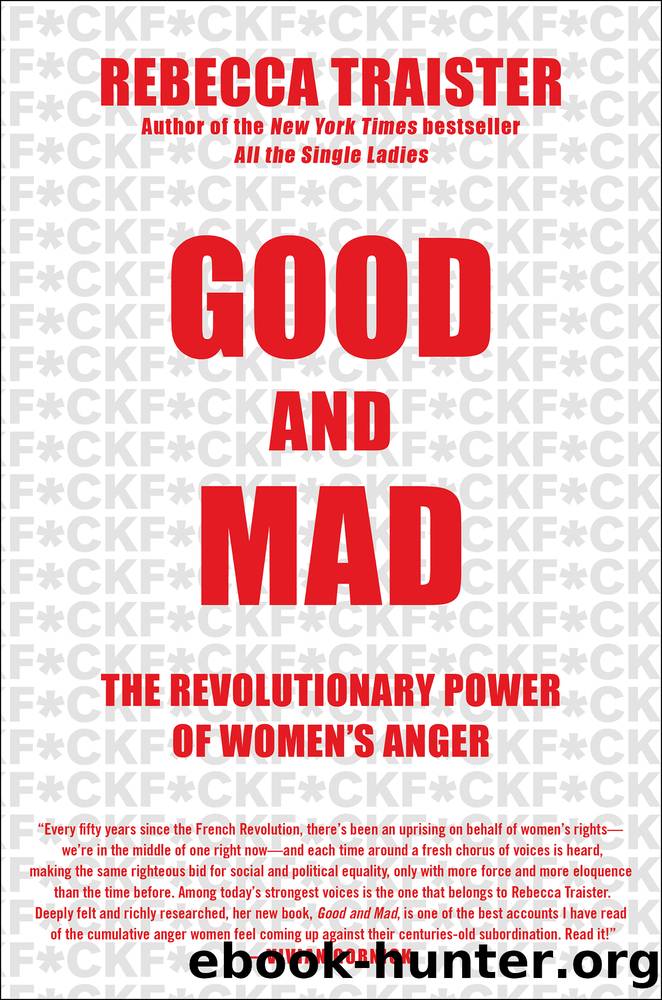Good and Mad_The Revolutionary Power of Women's Anger by Rebecca Traister

Author:Rebecca Traister [Traister, Rebecca]
Language: eng
Format: epub
Tags: feminism, Politics
Amazon: B07CL2HHZZ
Publisher: Simon & Schuster
Published: 2018-10-02T04:00:00+00:00
EPITAPH
On the day that Frederick Douglass died in 1895, he had spent the morning with Susan B. Anthony at a meeting of suffragists. In fact, heâd had such a good time that he had been in the midst of telling his wife about the meeting when heâd fallen to his knees, hands clasped, and his wife had simply believed that his pose was one of narrative enthusiasm, not realizing that he was in fact dying.
âIt is a singular fact,â the New York Times reported in Douglassâs obituary, âthat the very last hours of his life were given in attention to one of the principles to which he has devoted his energies since his escape from slavery. . . . Mr. Douglass was a regularly enrolled member of the National Woman Suffrage Association, and had always attended its conventions.â The obituary noted that his companion at the suffrage meeting that day was âMiss Anthony, his lifelong friend,â and that when âMiss Susan B. Anthony heard of Mr. Douglassâs death, at the evening session of the council, she was very much affected. Miss Anthony has a wonderful control over her feelings, but tonight, she could not conceal her emotion.â91
The racism that had riven the womenâs movement had by no means abated, nor would it anytime soon; twenty years later, one of the next generationâs white suffrage leaders, Alice Paul, would try unsuccessfully to force her elder, the black suffragist and anti-lynching leader Ida B. Wells, not to walk with her stateâs delegation in the enormous 1913 suffrage march on Washington, DC, but instead to march with the rest of the black women suffragists where theyâd been told to position themselves: behind all the white women. And the year that he died Anthony had asked Douglass not to appear at a suffrage convention in the South, because she was trying to strategically win white women to the cause. But neither did women of any race have the vote, nearly six decades after the first meetings of the black and white women joining to push for abolition, more than forty years after Douglass had joined Stanton at Seneca Falls.
Frederick Douglass was seventy-eight at his death; Susan B. Anthony would die eleven years later at eighty-six. Elizabeth Cady Stanton, who had turned to such baldly racist rhetoric in her anger at the inclusion of black men in the franchise before she herself had won the vote, was seventy-nine at the time of Douglassâs death and would live another seven years. Near the end of his life, Douglass would observe of their linked battles, âWe should all see the folly and madness of attempting to accomplish with a part what could only be done with the united strength of the whole.â92
None of the three, of course, would live to see the passage and ratification of the Ninteenth Amendment, much less conceive of the Voting Rights Act. In fact, only one woman who attended the Seneca Falls convention would survive long enough to cast a ballot after the ratification of the Nineteenth Amendment.
Download
This site does not store any files on its server. We only index and link to content provided by other sites. Please contact the content providers to delete copyright contents if any and email us, we'll remove relevant links or contents immediately.
| General | Men |
| Women in History |
Cecilia; Or, Memoirs of an Heiress — Volume 1 by Fanny Burney(32054)
Cecilia; Or, Memoirs of an Heiress — Volume 3 by Fanny Burney(31450)
Cecilia; Or, Memoirs of an Heiress — Volume 2 by Fanny Burney(31402)
The Great Music City by Andrea Baker(30778)
We're Going to Need More Wine by Gabrielle Union(18625)
All the Missing Girls by Megan Miranda(14705)
Pimp by Iceberg Slim(13771)
Bombshells: Glamour Girls of a Lifetime by Sullivan Steve(13680)
Fifty Shades Freed by E L James(12908)
Talking to Strangers by Malcolm Gladwell(12864)
Norse Mythology by Gaiman Neil(12819)
For the Love of Europe by Rick Steves(11431)
Crazy Rich Asians by Kevin Kwan(8883)
Mindhunter: Inside the FBI's Elite Serial Crime Unit by John E. Douglas & Mark Olshaker(8696)
The Lost Art of Listening by Michael P. Nichols(7157)
Enlightenment Now: The Case for Reason, Science, Humanism, and Progress by Steven Pinker(6869)
The Four Agreements by Don Miguel Ruiz(6310)
Bad Blood by John Carreyrou(6271)
Weapons of Math Destruction by Cathy O'Neil(5824)
